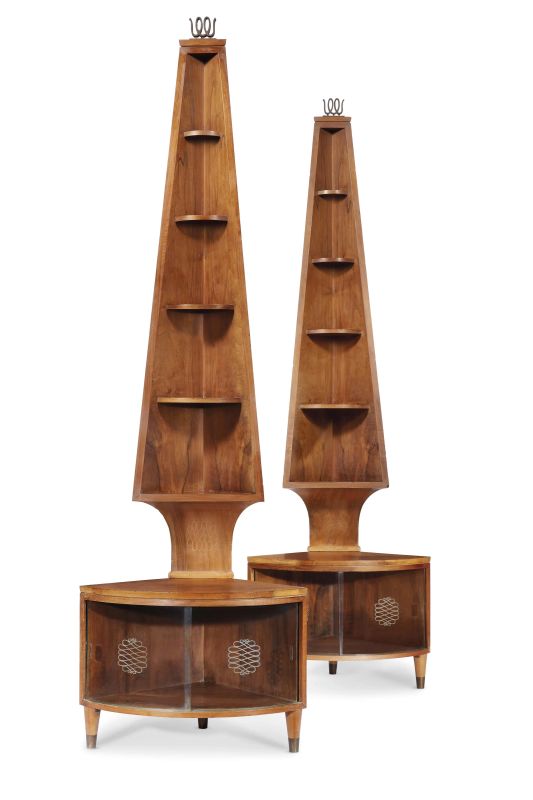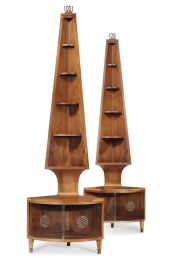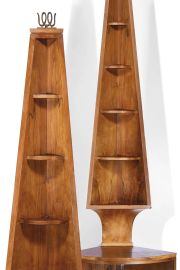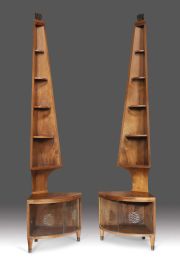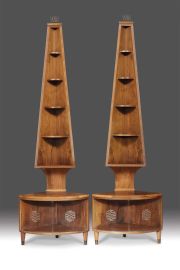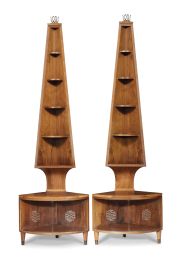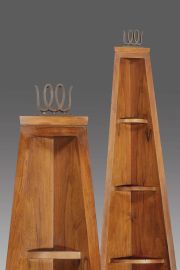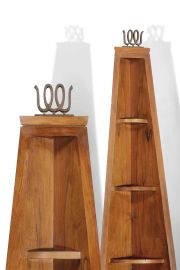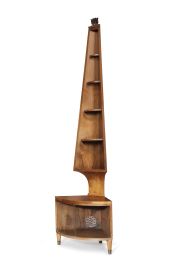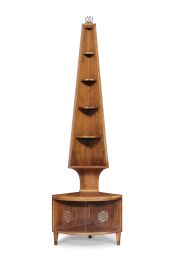Gio Ponti
(Milan. 1891-1972)
A PAIR OF CORNER CABINETS FOR THE CONTINI BONACOSSI RESIDENCE, VILLA VITTORIA, FLORENCE, 1932
walnut, brass, glass
Manufactured by Quarti cabinet-makers of Milan
height: 256 cm, depth: 55 cm
Appraisal delivered by the Gio Ponti Archives, no. 18145/000, on 10 September 2018
An export licence is available for this lot.
Provenance
Residenza Contini Bonacossi, Villa Vittoria, Florence;
Private collection by descent from the above, Florence
Literature
Alcuni mobili di Tomaso Buzzi e di Gio Ponti nella dimora dei Conti C. in Firenze, “Domus”, n. 71, November 1933, pp. 578-579;
U. La Pietra (ed.), Gio Ponti, Milano 1995, p. 50 fig. 116;
E. Colle, A. Lazzeri, Villa Vittoria. Da residenza signorile a Palazzo dei Congressi di Firenze, Firenze 1995, p. 75;
I. de Guttry, M.P. Maino, Il mobile déco italiano. 1920-1940, Bari 2006, p. 214 fig. 16
VILLA VITTORIA. GLI AMBIENTI ED IL LORO ARREDO
Enrico Colle
Alessandro Contini Bonacossi was born in Ancona in 1878. With his wife Vittoria Galli, he commenced his activity as a collector and dealer in paintings and sculptures, primarily works by artists of the Italian schools, during his stay in Spain, which lasted until 1918 when he moved to Rome with his family. During those years, Contini travelled many times to the United States, where he met numerous fellow collectors with whom – besides closing advantageous deals which permitted him to considerably augment his collection – he forged lasting friendships. Thanks to their frequentation of the homes of New York’s magnates and to their relationship with Piemontese industrialist and collector Riccardo Gualino, an attentive admirer of the trends in the art and architecture of his time, the Continis developed a refined taste in furniture and furnishings as well.
When they moved to Florence, Alessandro and Vittoria Contini Bonacossi’s appreciation of the solemn and at the same time functional villa built by Marchese Massimiliano Strozzi in that area of the city which at the time was still known as Valfonda was immediate; they saw the building – of recent construction but of noble origins – as the ideal venue to which to transfer their collection. The spacious rooms, with their austere neo-16th-century decoration, were well suited to showcasing the masterpieces of Italian Renaissance and Baroque painting and sculpture which the Continis had purchased, along with objets d’art and furniture, from the very early years of the 20th century onward; and the top floor of the villa lent itself admirably to rational reconstruction for conversion into a comfortable, elegant living space. The villa was purchased in 1931, renamed Villa Vittoria in honour of Contini’s wife, and soon refurbished according to precise museum layout criteria: the ground and first floors became home to the old masters collection, while the second floor, where the owners also lived, hosted works by contemporary artists.
During the years the family was in Florence, the best-known private collections were those of Frederick Stibbert, Herbert Horne, Stefano Bardini and Elia Volpi. A common denominator linked all these collections, amassed between the late 1800’s and the early years of the 20th century: imaginative, original arrangements of the pieces in rooms filled to capacity with objects and artworks. The only non-adherent to this style was Bernard Berenson, who in his villa I Tatti arranged his paintings and objets-d’art along the walls at a correct distance to keep them from ‘interacting’ with one another. The Continis took Berenson’s home as their model and placed their period pieces in sober, suggestive surroundings that strongly favoured rarefaction over accumulation. Then again, over the course of the Twenties Italian architects and interior designers tended more and more to exclude profuse displays of objects in rooms, preferring a style of furnishing that was more functional but in which even the work of ancient art had its precise place.
Complementing their celebrated collection of ancient art, the Continis had also begun to purchase works by contemporary artists, which they arranged on the top floor of the villa where the family habitually resided; a special layout was created, with furnishings designed by then-emerging architects Gio Ponti and Tommaso Buzzi of Milan and Giulio Rosso of Rome. The apartment, completed in 1932 or at the latest in the winter of the following year, was the subject of an article published in the November 1933 issue of Domus magazine: alongside numerous images of the rooms, the article pointed up how the architects had succeeded in harmoniously introducing the Continis’ works of contemporary art and their own modern furniture into a ‘purely classical Florentine ambience’. The challenge here was, in fact, to create furnishings that could serve the owners’ everyday living needs and at the same time valorise the family’s superb collection of paintings and sculptures by modern Italian artists. The choices of the two architects of the neoclassical Milanese school, which looked to the Lombard artisan tradition of which Albertolli and Maggiolini were the foremost exponents, seconded that univocal stance against the eclecticism reminiscent of D’Annunzio and Umberto I promoted by the Contini Bonacossi family. In the furniture designed for the ‘Vittoria’s Bedchamber’ and the ‘Modern Painting Gallery’, Buzzi and Ponti reprised several ideas from the designs for interiors presented at a contest called in 1926 by Rivista illustrata del popolo d'ltalia magazine, the theme of which was the furnishing of an Italian embassy. On that occasion, as later on in the furniture for the Continis, Ponti and Buzzi united the wall decorations with the furnishings with ‘delicate art and sure instinct’, drawing on ‘the late 18th-, early 19th-century Italian tradition’ without slavishly serving it. The two architects, as we read in the pages of Architettura e Arti Decorative magazine, succeeded in avoiding ‘the dual danger of excessive adherence to the forms of the ancient styles and of a facile orientation toward forms that are undoubtedly noble and modern, but not Italian’.
OMAGGIO A GIO PONTI, CATALOGO DELLA MOSTRA AL PALAZZO DELLA PERMANENTE, MILANO 1980
Rossana Bossaglia
Between 1930 and 1931, as the dates on the preparatory drawings for the project tell us, Gio Ponti began designing a set of items of furniture for the palazzo of the Contini Bonacossi family in Florence, beginning with those for the picture gallery: benches, chairs, a low table, consolles. The work continued with furnishing of various other spaces in the home . . . Ponti designed various other pieces of furniture, and in particular a grouping for the large lounge/sitting room . . .
The sequence of furniture we owe to Ponti lends itself admirably to a simplification of the passage from the Deco style – of which Ponti was a star in the first post-war decade – to the Novecento style . . .
Furnishing of the Contini home was a golden opportunity to design a suite which was luxurious but not simply for show; one which did not forgo any criterion of habitability, especially in the case of the pieces designed for the comfortable sitting room, designed to project a easygoing tone and a soft-pedalled opulence . . .
In his passage to the furnishings of the sitting room, irony falls by the wayside; Ponti again finds his inspiration in presumptive Roman furnishings. Lithe outlines, with their evident linear tensions, are replaced by full, solemn and at the same time placid forms which not only better correspond to the ‘warmer’ concept of an ambience given over to conversation and passing the time but also to a concept of sustained decorum. The intellectual game has bowed to an ideal exhumation: well-being is underlined by the peaceful middle-class appearance of the whole, while the expressive salvo and stressing of the room’s importance are left to archaeological inspiration.
In regard of these furnishings, produced by a highly elaborate technique by a quality manufactory, that of Mario Quarti, we may speak of an ‘aulic Novecento’; that is, a style which interprets the rationalist lesson in the sense that it rejects a brash predominance of decoration but, as it re-proposes symbolic ancient models, aligns itself more with neoclassical than with functional architecture.
That even at this point on his inventive parabola Ponti, underneath it all, flashes a sly smile is also true: the artist is never totally ‘serious’ or staid; his talent lies in gracefulness. The idea of an refined, exclusive ambience that in a modern key mock-mimics classical antiquity is an idea, it has been said, that is not ironic – but certainly brilliant. It is the response of a just man to the strutting archaeological academicism of the 1930s.
VILLA VITTORIA DA RESIDENZA SIGNORILE A PALAZZO DEI CONGRESSI IN FIRENZE, FIRENZE 1995, P. 9
Federico Zeri
Widely known for its collections of ‘ancient’ art, Villa Vittoria was also (on its second floor, where the owners resided) a masterpiece of Italian 20th-century interior furnishing. I can’t imagine where, today, one could find furniture and the other furnishings designed by Tommaso Buzzi and by Gio Ponti and manufactured by such masterful cabinet-makers and bronze-workers . . .
Those desks, those chairs, those doors, those bookcases opened my eyes to the exceptional quality of the inventiveness, the ‘style’, and the workmanship that characterised Italian architecture and artisan production from the late 1920s through the following decade.
GIO PONTI
Milan 1891-1972
Gio Ponti was a key figure in the history of Italian design, the most authoritative artificer of renewal in the Italian decorative arts in the Twenties and Thirties. Appearing on the design scene during a period of great stylistic uncertainty, he responded to the call for a ‘return to order’ that wound through the European art world at the time, identifying recovery of classicism as the road to overcoming the confusion and poor taste of the prevailing neo-eclecticism. He was blessed with inexhaustible creative exuberance and approached architecture and design of objects and furnishings with equal commitment; whenever the occasion arose, with his words, writings, exhibitions, works, he fought to circulate his conceptions of aesthetics and culture.
Chiefly as concerned furnishings, and furniture design in particular, Ponti’s ‘well-mannered’ yet ironic neoclassical taste, ideally derived from early 19th-century Lombard style, was so original and incisive as to gain a premier place for itself and stand as a model for other designers. In the second half of the Twenties, a real, although non-institutionalised, ‘Milanese School’ coalesced around Ponti and the architects most closely-associated with him – Buzzi, Lancia and Marelli. Ponti’s items of furniture, with their unadorned, graceful profiles and exquisite artisan workmanship, in precious woods finished with metal trim – in gilded, silvered, green-patinated bronze – are one-of-a-kind luxury pieces intended for a wealthy upper middle class clientele.
LA CASA ALL'ITALIANA
La casa all’italiana non è il rifugio, imbottito e guarnito, degli abitatori contro le durezze del clima, come è delle abitazioni d’oltralpe ove la vita cerca, per lunghi mesi, riparo dalla natura inclemente: la casa all’italiana è come il luogo scelto da noi per godere in vita nostra, con lieta possessione, le bellezze che le nostre terre e i nostri cieli ci regalano in lunghe stagioni…
La casa all’italiana è di fuori e di dentro senza complicazioni, accoglie suppellettili e belle opere d’arte e vuole ordine e spazio fra di esse e non folla o miscuglio. Giunge ad esser ricca con i modi della grandezza, non con quelli soli della preziosità.
Il suo disegno non discende dalle sole esigenze materiali del vivere, essa non è soltanto una “machine à habiter”. Il cosiddetto “comfort” non è nella casa all’italiana solo nella rispondenza delle cose alle necessità, ai bisogni, ai comodi della nostra vita ed alla organizzazione dei servizi.
Codesto suo “comfort” è in qualcosa di superiore, esso è nel darci con l’architettura una misura per i nostri stessi pensieri, nel darci con la sua semplicità una salute per i nostri costumi, nel darci con la sua larga accoglienza il senso di una vita confidente e numerosa, ed è infine, per quel suo facile, lieto e ornato aprirsi fuori e comunicare con la natura, nell’invito che la casa all’italiana offre al nostro spirito di ricrearsi in riposanti visioni di pace, nel che consiste, nel pieno senso della bella parola italiana, il conforto.
Gio Ponti, in Domus, Gennaio 1928
MODERNO O NON MODERNO
Si disente e fervorosamente su questi termini. Vi son pochi argomenti anzi che più di questo facciano inferocire gli spiriti. Io vedo spesso brave, calme, educate persone congestionarsi perdere le staffe, perder lo stile appena pronunciano queste fatali parole: moderno, novecento. Non voglio certo attaccare polemiche: questa pianta fiorisce già da se nei giardini artistico-letterari d’Italia. Lasciamo andare anche le designazioni particolari che ha l’appellativo di novecento riferito a gruppi d’artisti, e badiamo invece al fenomeno. Lasciamo andare polemiche, definizioni, uomini, parti e fazioni e guardiamoci attorno considerando cose moderne o novecento quelle che sono del millenovecento.
Gio Ponti, in Domus, Novembre 1933

